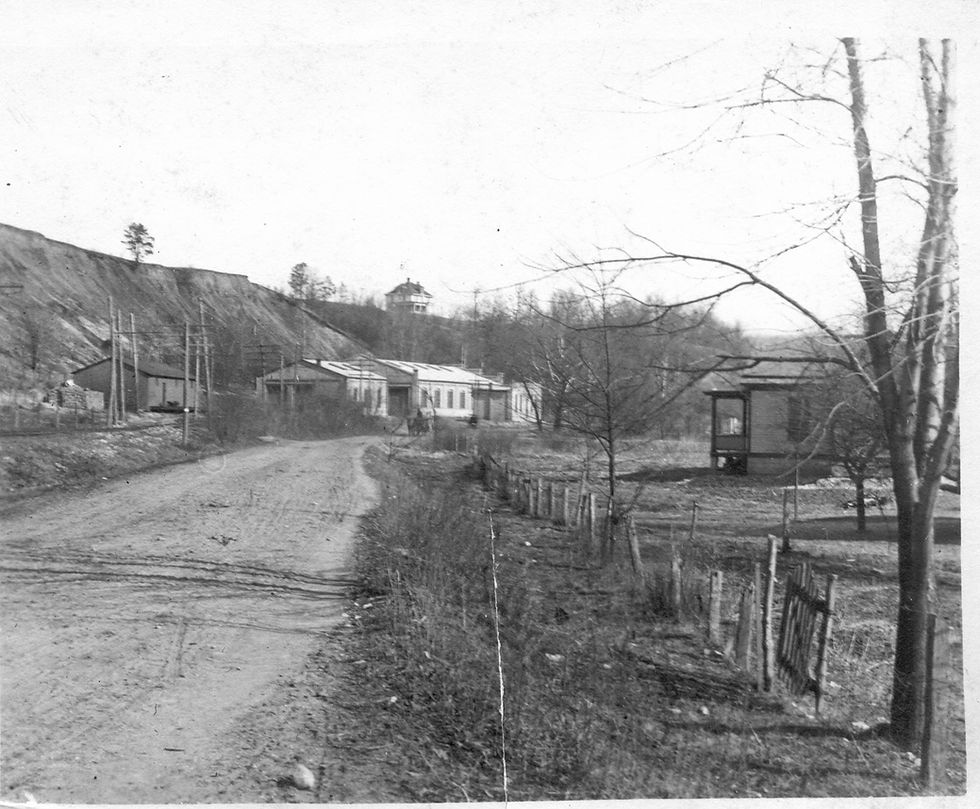Visionary John S. Mainland laid the groundwork for early baseball expansion
- Mary Lou Montgomery

- Apr 15, 2017
- 5 min read

This photo, taken circa 1910, shows the streetcar barn of the old Hannibal Electric Railway, on Market Street. The building, which has now been replaced by a newer building, was used much later by the Hannibal Quincy Truck Lines. The house atop the bluff belonged to Sinclair Mainland, owner of the Hannibal Electric Railway. This photo was taken by Anna Schnitzlein and is from Steve Chou’s photo collection. It is featured in “Hannibal Missouri Bluff City Memories” by Steve Chou.
MARY LOU MONTGOMERY
John S. Mainland, among Hannibal’s wealthy citizens in 1909, was keenly aware of the problems associated with Central Division baseball. As manager of the Hannibal Street Railway Co., he had made accommodations to expand the streetcar line to include Lyon Street, so that fans could ride by rail to Lyon and Glasscock streets, just a few blocks from League Field, where the Hannibal Cannibals played during their first season with the minor league.
As explained in last week’s story (Hannibal Courier-Post, April 8, 2017) a suit filed by neighbors in the McComb/Lemon street neighborhood put a halt to baseball games in the area that now serves as the site of Hannibal’s sewage treatment plant. The neighbors called organized baseball a public nuisance, and Judge David Eby of the Hannibal Court of Common Pleas agreed.
Hannibal’s dream of hosting a minor league team squashed, Mainland knew how badly Hannibal businessmen and blue collar workers alike wanted an organized baseball team to cheer for during the spring and summer.
But without a suitable field, it would be impossible for the town to attract such a sports venue.
Two years prior, in 1907, Mainland and Thos. O’Dell, who was charge of the construction work, erected a new street car barn between Oakwood and Hannibal.
Mainland and his extended family lived on a steep hill to the north of the streetcar barn. To the south, Mainland owned more property.
Looking out to the south from the vantage point of his hilltop house, he concocted a plan for a new ball park.
Where Bear Creek flows to the south of Market Street – an area directly to the south of his new streetcar barn – the creek divides, forming an island. Mainland was a visionary, and concluded that this island would be the perfect spot for a ball field.
He got to work on a plan to bring his vision to life.
1912
The field was ready for the 1912 baseball season, and the Hannibal Eagles were part of the Three I League.
On May 2, 1912, the Hannibal Eagles hosted Egan’s “Speed Boys” of Ottumwa, Iowa, for the first game of the baseball season. John S. Mainland’s new baseball park featured both a grandstand and bleachers, and a large crowd gathered for the sporting match. Hannibal beat Ottumwa, 3-2.
But Mainland’s vision for a sports complex didn’t stop at baseball.
In the fall of 1912, Mainland Field served as the site for a grudge match between Hannibal High School’s Red and Black, led by Coach Anderson, and Quincy.
The following players were announced by Coach Anderson:
R.E., Richmond-Velie-Wright; R.T., Capt. Lewis; right guard, Mangles-Phillips; C., Spencer; left guard, Carter-Wheelock; left tackle, Sultzman; L.E., Anderson-Tippy-Gettler; Q., Raible; L.H., Hafner; F. Merriman; R.H., Brashears-Foster.
Hannibal was victorious, 20 to 7.
As the years moved forward, Mainland Field continued to serve as the primary venue for school and semi pro sports. In addition to baseball and football, track meets took place at the park.
In May 1916, John Mainland arranged for the erection of a new grandstand at the field, to meet the demand for more seating. During the previous season, fans had been turned away due to the lack of space.
But the unpredictable Bear Creek wasn’t respectful of Mainland’s investment. High waters washed over the island once, then again in mid August 1916. The second flood, which left 2,000 residents of the Bear Creek bottoms homeless, and also ruined the field and washed out the bridge leading to the small island.
Mr. Mainland reinvested in the park, promising to replace the old bridge to the island with one built of iron, despite the baseball organization’s $3,000 loss during the 1916 season.
1917
Sinclair Mainland, son of John S. Mainland, was 28 and single in 1917, and lived with his father on the hilltop home the family had named Overlook Place. He had completed his studies at the University of Missouri-Columbia, and was now following his father’s footsteps in the streetcar business.
Sinclair was called to serve during World War I, from Nov. 27, 1917, to Dec. 17, 1918, as an officer, Second Lt. Infantry, Co. 12, Machine Gun Training Center.
Before his son returned from the war, John S. Mainland died, on Sept. 5, 1918.
1919
The heyday of Mainland park likely came in 1919, when Hannibal’s Labor Day celebration took place on the island. The Quincy Daily Whig described the scene in its Aug. 31, 1919 edition:
“For the last few days the baseball park at Mainland’s Field has been a busy scene with carpenters, electricians and other workmen converting the place into a wonderland. It will be a miniature Coney Island for the one day and will be the scene of the festival following the parade” (beginning on East Broadway.)
The following month, the Mainland estate leased the park to a newly formed organization, the Robal Amusement Company. The company was backed by members of Hannibal trades and Labor assembly In 1920, and a dancing pavilion was built on the island, eighty feet long and fifty feet wide. Dances with live music were planned two to three times per week. Robal Park was located to the west of the ball field.
Five years later, the grandstand at the park burned, with an estimated loss of $5,000. All three Hannibal fire companies responded to the alarm, but arrived too late to save the structure.
1925
Clemens Field was prepared as a baseball venue prior to the start of the April 1925 season. Constructed along the Wabash tracks parallel to Bear Creek, the park was surrounded by a wooden fence. The game on Sunday, April 27, 1925, dedicated the new baseball park. The park had a seating capacity of about 3,000 people and about 2,500 people witnessed the game.
In June 1927, a windstorm whipped through the Bear Creek area. A large section of the board fence around Clemens field was blown down onto the Wabash tracks, but was soon removed.
At the site of the old League Field, the Wabash roundhouse, situated near what were then known as the carnival grounds, was unroofed and one wall was blown in.
On west to Robal park (and the old Mainland Field), the Wabash track was reported to be littered with trees and poles. A big tree obstructed the Wabash at a point near the outer depot, which was located at Lindell Avenue.


































Comments